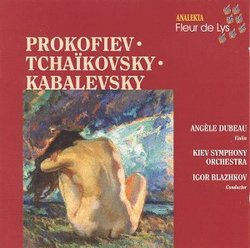| All Artists: Sergey Prokofiev, Pyotr Il'yich Tchaikovsky, Dmitry Kabalevsky, Igor Blazhkov, Kiev Symphony Orchestra Title: Prokofiev, Tchaikovsky, Kabalevsky: Violin Concertos Members Wishing: 0 Total Copies: 0 Label: Analekta Release Date: 12/12/1995 Album Type: Import Genre: Classical Styles: Chamber Music, Forms & Genres, Concertos, Historical Periods, Classical (c.1770-1830), Instruments, Strings Number of Discs: 1 SwapaCD Credits: 1 UPC: 774204303624 |
Search - Sergey Prokofiev, Pyotr Il'yich Tchaikovsky, Dmitry Kabalevsky :: Prokofiev, Tchaikovsky, Kabalevsky: Violin Concertos
 | Sergey Prokofiev, Pyotr Il'yich Tchaikovsky, Dmitry Kabalevsky Prokofiev, Tchaikovsky, Kabalevsky: Violin Concertos Genre: Classical
Prokofiev Concerto no. 1 in D major, op. 19 The Parisian public became acquainted with the music of Russian composer Serge Prokofiev in 1921, when his compatriot, Serge Koussevitzky, conducted the Scythian Suite. The wo... more » |
Larger Image |
CD Details
Synopsis
Album Description
Prokofiev Concerto no. 1 in D major, op. 19 The Parisian public became acquainted with the music of Russian composer Serge Prokofiev in 1921, when his compatriot, Serge Koussevitzky, conducted the Scythian Suite. The work was received with some reservation, but the composer's reputation would later grow, thanks to works like the Chout ballet and the Concerto No. 1 for violin and orchestra. Prokofiev had begun his concerto in 1913 but completed it only in 1917. For various reasons, the first production did not take place until 1923 at the Paris Opera, under the direction of Koussevitzky, with violinist Marcel Darrieux as soloist. However, it was Joseph Szigeti who was to popularize the work, performing it in in Prague in 1924 and in Boston the following year. With the exception of the central movement, a dizzying scherzo where the virtuosity of the soloist is harshly put to the test, the concerto is noteworthy for its lyrical strains. The orchestration of the work is also appealing because of its clarity and transparency. Tchaikovsky Sérénade mélancolique, op. 26 Before writing his unique concerto for violin, Tchaïkovsky found himself being asked for a new work by Leopold Auer, the famous virtuoso and teacher. He accepted this invitation by composing the Sérénade mélancolique for violin and orchestra in 1875. Although this work is dedicated to Auer, it was Adolf Brodsky who premiered it in Moscow on January 28, 1876, Auer considering the work "unplayable." The Serenade mélancolique offers two themes of astonishing strength, detailed with great artistry and sincere emotion. Mélodie in E-flat major, op. 42 no. 3 During the winter of 1877-1878, Tchai-kovsky travelled to Italy and Switzerland. During these travels, he met Joseph Kotek, with whom he played a lot of music. This inspired him to undertake the composition of his celebrated concerto, completing the outline in 11 days and the orchestration in 15 days. However, he did not like the slow movement and substituted it with a canzonetta. The original movement, Meditation, became the first movement of the suite Souvenir d'un lieu cher, of which the Mélodie is the third movement. Orginally written for violin and piano, this piece was arranged for orchestra in 1878 by Glazunov. Its lyricism calls to mind the most tormented parts of the Eugene Oneguine opera. Kabalevsky Concerto no. 1 in C major, op. 48 Born in St. Petersburgh, Kabalevsky was 21 when he began to study piano and composition at the Moscow Conservatory. This late start did not prevent him from producing an abundance of works: four symphonies, five operas and numerous instrumental works, one part of which is educational in nature; he has also written concertos for the violin and the cello, as well as three concertos for piano. Conceived in the classic tradition of three movement, the Concerto for violin and orchestra, intended for the great Soviet virtuoso David Oistrakh, who assured its creation and recorded it in 1951 with the National Orchestra of the U.S.S.R. under the direction of its composer, was composed in 1948. In this work, the violin exchanges lively dialogues with the orchestra, dissolves in the sweeping phrases of the strings, or leads the movement with inexhaustable vigour.

 Track Listings (8) - Disc #1
Track Listings (8) - Disc #1